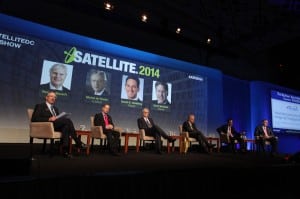Latest News
[Via Satellite 03-11-14] Chief executives from the satellite industry’s largest players kicked off SATELLITE 2014 sharing the opportunities and challenges ahead. The overall tone from the leaders of Eutelsat, Intelsat, SES and Telesat was upbeat, and with good reason: many of their fleets are growing and new waves of innovation by SpaceX.
Via Satellite Editor Mark Holmes began the conversation asking executives what excites them most about the future. David McGlade, CEO of Intelsat, pointed to mobility and the convergence of MSS and FSS, while Telesat CEO Daniel Goldberg said that seeing such strong demand across many segments has enabled his firm to procure new capacity and look at new architectures of how satellites are designed. Referencing the innovation occurring in the launch space, too, Goldberg observed, “It’s fun right now to sit with colleagues and customers and plan the future.”
Michel de Rosen, CEO of Eutelsat, noted that 80 percent of future growth in satellites will be in the southern hemisphere, which is why he’s so excited about Eutelsat’s acquisition of Satmex. “We had no presence in Latin America … this content will provide significant growth for many years,” he said.
Clearly, the satellite market is seeing dramatic change from the launch of new high-throughput satellites, to the dramatic drop in launch costs brought on by gutsy new entrants like SpaceX. Having more affordable and reliable launch options is welcome news to all these veterans, particularly Romain Bausch, president and CEO of SES, who was the first commercial customer to use SpaceX’s Falcon 9 rocket for the launch of SES 8 satellite — the highest profile of SES’s three launches last year.
A key area of discussion centered on WRC-15 and the push to obtain C-band spectrum at the World Radiocommunication Conference (WRC) in November 2015. The satellite industry is escalating efforts to stop terrestrial industry from getting governmental authority to roll out wireless broadband over extended C-band. Studies have shown that International Mobile Telecommunications (IMT) services interfere with fixed service satellites, which remain a mainstay of the global satellite portfolio, accounting for 38 percent of the satellite mix (not counting HTS), according to satellite analyst firm, NSR.
However, CEOs in the panel were optimistic and agreed that the industry will not face a “doomsday scenario” next year in Geneva.
They point out that, unlike seven years ago, the industry has joined together much earlier to communicate the critical role C-band and other satellite frequencies play in the world, especially in bringing access to the world’s rural and poor communities. The leaders also said that the “studies” the wireless sector has issued on their need for spectrum are exaggerated by “two orders of magnitude,” which further underscores the need for education and outreach to political leaders, who often know much less than regulators, the panel said.
“Telling this story is so important,” McGlade said, noting that this type of “land grab” could easily expand to other frequencies. Eutelsat’s de Rosen agreed. “We must think ahead. If we are to be passive about C-band or L-band the threat would be on Ku and Ka,” Rosen added.
Noting the Big Four’s combined revenue growth at around 3 to 4 percent in 2013, Holmes questioned the leaders if they thought their prospects for growth would improve in the future. Many panelists pointed to key emerging markets as a driver for their growth. Eutelsat expects growth of 5 percent in the next few years, while SES pointed to 6 to 7 percent growth this year alone.
Intelsat’s McGlade called on a change of the economics of the industry as key to the satellite sector’s long-term growth. “We have to be more relevant, more efficient, we have to push the boundaries,” he said, noting that the industry needs to both drive down costs and expand the market through innovation.
Later, McGlade made a memorable observation when the discussion turned to ways the industry could attract the next-generation of talent. “We’ve got to show what is cool about our industry. It hasn’t hurt to have Elon Musk redefining our industry,” he said.
The talent challenges may be less acute in Europe, where SES and Eutelsat say they don’t have the same difficulty attracting young people into their companies. However, one challenge, de Rosen admitted, was diversity. “We must do more to make sure women feel they have as many chances to be successful in the company as men,” he said.
Get the latest Via Satellite news!
Subscribe Now